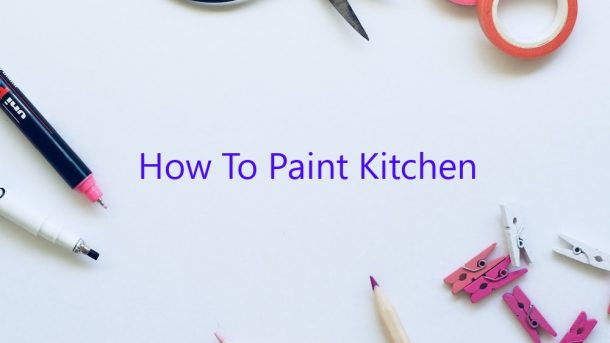How to Paint a Kitchen
One of the most popular home improvement projects is painting a kitchen. Whether you are remodeling or just freshening up the look, it is a relatively easy project that can have a big impact.
The first step is to remove everything from the cabinets and drawers. This will make the painting process much easier. If you are painting the walls, too, it is a good idea to remove the cabinet doors and hardware and paint them separately.
Next, you will need to sand the surface to be painted. This will help the paint adhere to the surface and will create a smoother finish. You can use a power sander or sandpaper, depending on the condition of the surface.
After sanding, you will need to wipe the surface clean and then apply a primer. This will help the paint to adhere to the surface and will help to create a longer-lasting finish.
Once the primer has dried, you can begin painting. Be sure to use a brush or roller that is appropriate for the surface and the type of paint you are using.
If you are painting the walls, it is a good idea to start with the ceiling and then work your way down. Paint in even strokes and be sure to overlap the strokes to avoid any streaks or missed spots.
For the cabinets and drawers, start with the front and then work your way to the back. Be sure to paint the inside of the cabinets, too.
Allow the paint to dry completely before putting the cabinet doors and hardware back on.
Painting a kitchen can be a simple and easy project that can dramatically change the look of your home. By following these simple steps, you can create a beautiful and lasting finish that will transform your kitchen.
Contents [hide]
In what order do you paint a kitchen?
When painting a kitchen, there are many factors to consider. You may be wondering what order you should paint in. The answer to this question will vary depending on the specific situation, but there are some general guidelines you can follow.
The first step is usually to paint the walls and ceiling. This will provide a solid base for the rest of the painting project. Once the walls and ceiling are finished, you can move on to the cabinets and trim. Finally, you can paint the floor.
If you are painting the cabinets a different color than the walls, it is usually best to paint the cabinets first. This way, you can avoid getting paint on the walls. If you are painting the trim a different color than the walls or cabinets, it is usually best to paint the trim last. This way, you can avoid getting paint on the other surfaces.
It is also important to take into account the order of the tasks involved in painting a kitchen. For example, if you are painting the cabinets first, you will need to allow time for them to dry before moving on to the next step.
In general, it is a good idea to plan out the order of the painting project before you start. This will help ensure that everything is done correctly and that the finished product looks great.
How do I prep my kitchen walls for painting?
There are a few things you need to do in order to prep your kitchen walls for painting. The first step is to remove all of the switch and outlet covers and clean them. You can use a damp cloth to clean them, but be sure to let them dry completely before you put them back on.
The next step is to remove all of the cabinet hardware and clean it. Again, you can use a damp cloth, but be sure to let it dry completely before you put it back on.
The next step is to remove the cabinet doors and clean them. You can use a damp cloth to clean them, but be sure to let them dry completely before you put them back on.
The next step is to remove the cabinet shelves and clean them. You can use a damp cloth to clean them, but be sure to let them dry completely before you put them back on.
The next step is to remove the wallpaper. If the wallpaper is easy to remove, you can use a wallpaper steamer to remove it. If the wallpaper is not easy to remove, you can use a wallpaper remover.
The next step is to patch any holes or cracks in the walls. You can use a patching compound to patch them.
The next step is to sand the walls. You can use a sanding sponge to sand them.
The next step is to prime the walls. You can use a primer/sealer to prime them.
The next step is to paint the walls. You can use a paintbrush to paint them.
Can you paint kitchen without sanding?
You might be wondering if it’s possible to paint your kitchen without sanding first. The answer is yes, but it’s not always recommended.
If your kitchen cabinets are in good condition and have a smooth surface, you might be able to get away with just a light sanding before you start painting. However, if your cabinets are older or have any imperfections, you’ll need to do a more thorough sanding to get a smooth surface.
If you don’t want to sand your cabinets, you can try using a primer that will help to cover up any imperfections. But, be aware that primer might not be enough to hide all the flaws, and you might end up with a less-than-perfect finish.
Ultimately, it’s up to you whether or not to sand your cabinets before painting. If you decide not to, just be sure to test the paint on a small area first to make sure it looks good.
What is the best type of paint to use in the kitchen?
The best type of paint to use in the kitchen is a water-based paint. Latex paint is a water-based paint and it is the best type of paint to use in the kitchen. Latex paint is durable, easy to clean, and it does not emit harmful fumes.
Do you have to wash kitchen walls before painting?
There is some debate about whether or not you need to wash your kitchen walls before painting them. Some people say that you don’t have to, but that you should if you want the paint to last longer. Others say that you definitely do have to wash them before painting, and that not doing so will result in the paint peeling or chipping.
So, what’s the truth? Well, it depends on the paint you use. If you’re using a latex paint, you probably don’t have to wash the walls, but if you’re using an oil-based paint, you definitely do have to. This is because latex paints are water-based, while oil-based paints are solvent-based.
Washing the walls before painting them is a good idea, regardless of what type of paint you’re using, because it will remove any dirt or grease that is on the surface. This will help the paint to adhere better, and it will also make it less likely that the paint will peel or chip.
If you’re not sure whether or not you need to wash your kitchen walls before painting them, it’s best to err on the side of caution and wash them. This will help to ensure that your paint job lasts as long as possible.”
Do you have to prime kitchen walls before painting?
Whether you have to prime kitchen walls before painting is a question that many homeowners have. The answer is that it depends on the condition of the walls and the paint that you plan to use.
If your kitchen walls are in fairly good condition and you are using a quality paint, you may not need to prime them. However, if the walls are in poor condition or you are using a less expensive paint, priming is definitely recommended.
Priming helps to seal the surface of the walls and provides a smoother surface for the paint to adhere to. This helps to ensure that the paint will not chip or peel and will last for a longer period of time.
If you are unsure about whether or not you need to prime your kitchen walls, it is always best to err on the side of caution and do so. Priming is a relatively inexpensive step that can help to protect your investment in painting your kitchen.
Can I just paint over old paint?
A lot of people may wonder if they can simply paint over their old paint, and the answer is yes – you can paint over old paint, but it’s not always recommended.
The main reason you’d want to paint over your old paint is if it’s in bad condition. The paint may be peeling, chipping, or flaking, and in this case, it’s best to just paint over it with a fresh coat.
However, if the paint is in good condition, you may not need to repaint. In most cases, you can just paint over the old paint with no problems.
There are a few things to keep in mind if you decide to paint over old paint. First, make sure the surface is clean and free of any dirt, dust, or debris. You may also need to sand down the surface to create a smooth surface.
Finally, make sure the new paint is compatible with the old paint. Not all paints are compatible with each other, so it’s important to check the labels before you start painting.




